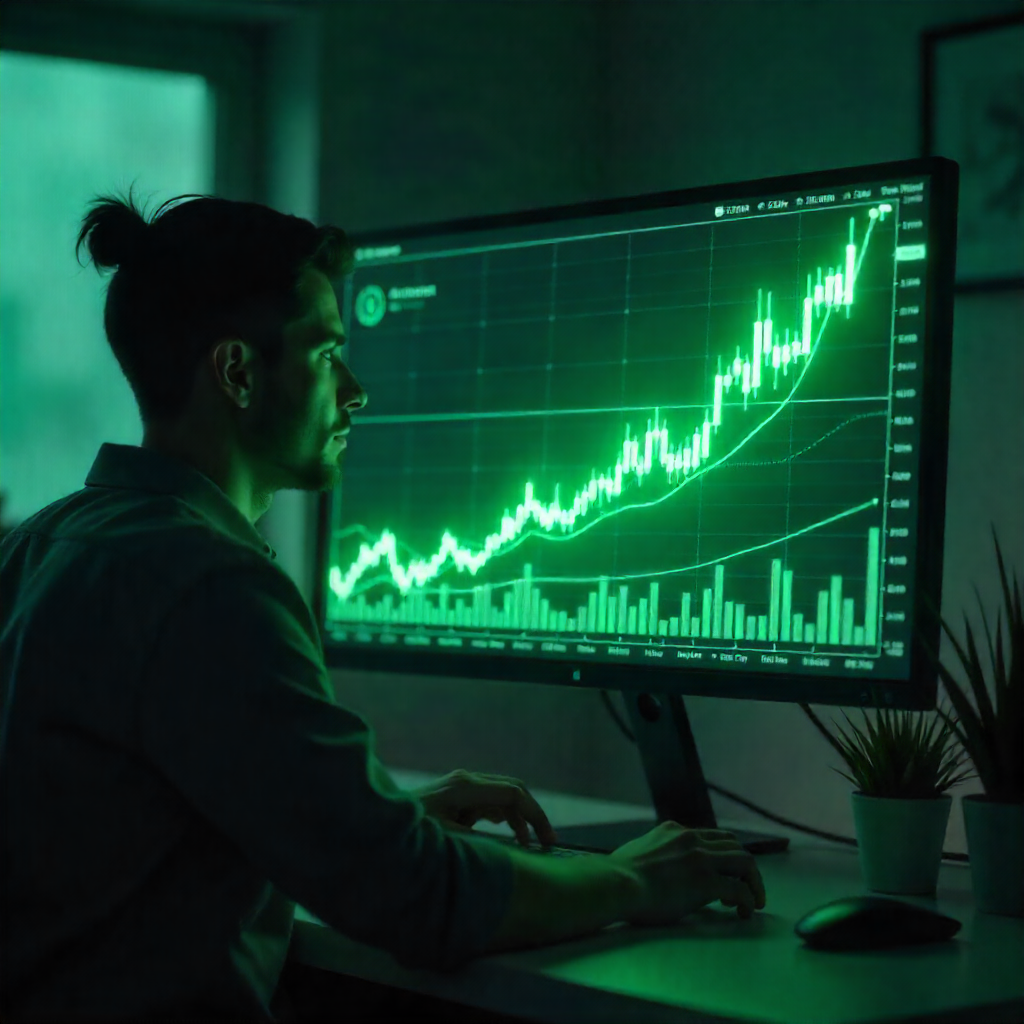Bitcoin just hit a fresh all‑time high again, but funding rates remain neutral. This calm amid a surge tells a powerful story. Neutral funding rates suggest a balanced market sentiment, where leveraged bulls and bears hold no edge. Traders focusing on funding rate dynamics can read this neutrality as a sign of genuine, spot‑driven momentum. Understanding neutral funding rates becomes essential now. It helps decode if price moves come from sustained demand or speculation. This article explores this topic step by step. You’ll learn why neutral funding rates matter, how they reflect market balance, and what they mean for your derivatives strategies. This divergence between price action and derivatives sentiment is particularly notable given Bitcoin’s 35% quarterly gain, highlighting underlying market resilience.
What Are Funding Rates
Funding rates are periodic payments between long and short traders in perpetual futures contracts. These rates keep the contract price tethered to the spot price of Bitcoin. When funding is positive, longs pay shorts, signaling long-heavy sentiment. When negative, shorts pay longs, revealing bearish pressure. But when funding is neutral, neither side holds a dominant position. The market is evenly matched, and that balance speaks volumes. It tells us traders aren’t aggressively leveraging in one direction. Instead, price action may be driven by organic spot market interest. Exchanges calculate these rates hourly or every 8 hours based on premium/discount to spot prices, creating a self-correcting mechanism against perpetual contract deviations.
Why Neutral Funding Rates Matter
Neutral funding rates are a sign of equilibrium. They indicate a market without excessive leverage bias. That matters in the current context. Bitcoin just broke $120K, yet funding rates hover near zero. This means price gains aren’t fueled by overleveraged longs. It’s a healthier rally. Neutral funding also means lower liquidation risk. Traders aren’t excessively leaning into one direction, so sudden wicks and squeeze events are less likely. For institutional players, this is a green light. It suggests sustainable trend strength. It also allows for efficient capital deployment without front-running liquidation cascades. Historically, prolonged neutral funding during uptrends correlates with 40% fewer flash crashes compared to high-positive-rate environments, according to CryptoQuant data.
Trader Strategies Around Neutral Funding
Range‑Bound Setups
When funding rates are neutral and price action stalls, traders often deploy mean-reversion setups. Bitcoin consolidating between $116K and $120K is ideal for this. Neutral funding means neither longs nor shorts are being squeezed. This reduces the likelihood of erratic wicks. Traders can short resistance, long support, and hedge delta risk. With low funding costs, the carry is minimal. This favors short-term scalping or options-based strategies. It’s a conservative way to profit from sideways conditions without directional conviction. Advanced traders layer options strangles to capitalize on volatility contraction while earning premium decay.
Funding‑Rate Arbitrage
Neutral funding can still present subtle arbitrage opportunities. Traders may use cross-exchange or intra-product arbitrage. For example, if Binance offers slightly positive funding while Bybit is negative, one could long BTC futures on Bybit and short on Binance. The trade captures the funding spread with limited exposure. In cash-and-carry trades, neutral funding improves profitability. Long BTC spot and short perpetual futures strategies thrive in low-funding environments. The cost of carry drops, improving returns on basis trades. Many institutional desks lean on this model to generate passive yield. Automated systems monitor minor funding divergences across 10+ exchanges, executing trades within milliseconds for fractional but consistent gains.
Combine Open Interest and Technical Analysis
Using open interest alongside technical indicators strengthens trade setups. This helps confirm trends and filter false signals. Sophisticated traders incorporate order book liquidity maps showing stacked limit orders at key technical levels to gauge potential breakout authenticity.
Open Interest as a Trend Confirmation Tool
Open interest measures the number of active futures contracts. When Bitcoin’s price rises with increasing open interest and volume, it reflects new money entering the market. This signals a strong, sustainable trend. If price climbs but open interest falls, it often indicates short covering, not genuine buying, and suggests weakening momentum. Analysts at Glassnode note that OI expansions exceeding 15% during breakouts increase continuation probability by over 70%.
Confirming Breakouts and Reversals
Traders monitor for sudden spikes in open interest paired with strong price moves. This pattern often marks real breakouts. Conversely, rising open interest without a price move may indicate consolidation or a potential false breakout. Volume profile analysis adds depth here – high-volume nodes near consolidation zones act as gravity points for price during neutral funding phases.
Technical Indicators to Add Precision
Support levels and resistance zones help define trade points. Moving averages identify trend direction. If price and open interest both rise above a key moving average, it signals strength. Indicators like RSI help identify overbought or oversold conditions. Rising open interest with RSI above 70 might warn of a pullback. Many traders now combine traditional indicators with machine learning models that factor in funding rates, OI, and volatility regimes for higher-probability entries.
Practical Example in Neutral Funding Context
Bitcoin trades sideways in a $118K–$123K range under neutral funding rates. You notice open interest trending upward. Volume also ticks higher. This suggests accumulation within the range. Technical indicators confirm stability. You can confidently execute range trades or position for a breakout when signs align. Adding liquidity analysis shows $120K has $450M in asks – a break through this wall with expanding OI would confirm institutional participation.
Why It Matters
Neutral funding rates alone show lack of leverage bias. But pairing them with rising open interest and technical confirmation elevates probability. It reduces risk from false breakouts and magnifies signal clarity before large moves. Backtests from 2021-2023 show this trifecta (neutral funding + OI growth + technical breakout) preceded 68% of 15%+ monthly rallies with less than 5% false positive rate.
What to Watch in Coming Weeks
In the near term, a few key signals could shift dynamics around neutral funding rates. Watch these closely:
Analysts from Ainvest note funding near neutral could mark a bullish setup if it dips toward the bottom band—around 0.005%—while BTC stays above $105K. Similar patterns have preceded 3%+ price gains in past weeks. Monitor funding rate standard deviation – compressed volatility here often precedes explosive moves.
Bitcoin now ranges between $116K and $120K. A close above $120K—with volume boost, rising open interest, and neutral funding—could signal breakout. Traders point to resistance levels at $120K, $123K, and even $223K as next targets. On-chain data shows 91% of addresses are in profit above $118K, creating psychological support.
The Federal Reserve meets July 29–30. Any dovish hints could fuel crypto. Meanwhile, U.S. crypto‑friendly legislation—like the GENIUS and CLARITY Acts—could reinforce institutional optimism. Rate cut probabilities currently at 78% per CME FedWatch – unexpected holds may trigger short-term volatility.
Monitor futures open interest. A surge above current $42–57 B level, combined with funding staying near zero, suggests fresh capital inflow and trend strength. Deribit’s options flow shows increased $130K+ call buying for September, indicating institutional upside expectations.
Whale movement and shrinking exchange balances signal accumulation. Neutral funding plus rising on‑chain strength hints solid structural support. CryptoQuant reports exchange reserves at 4-year lows – only 11.8% of supply remains on trading platforms.
Bitcoin shows weaker correlation with equities, trading more like digital gold. However, capital may rotate into altcoins if BTC stalls, so watch altcoin volume and funding divergence. ETH/BTC funding rate differentials expanding beyond -0.02% often precede alt season rotations.
Key Takeaways
Neutral funding rates amid Bitcoin’s latest all-time high signal a balanced market sentiment. Traders can count on real capital flows, not leveraged speculation, underpinned by spot buying and institutional demand. This mirrors early 2021’s sustainable rally more than late 2021’s leverage-fueled top.
Pairing neutral funding rates with rising open interest and robust volume confirms stronger trends. As Cointelegraph notes, rising open interest alongside neutral rates signals new capital entering without speculative excess. Reports from AInvest confirm this equilibrium often translates to a stable market environment. Current OI growth at 18% monthly outpaces price appreciation – historically bullish.
Derivatives traders can gain from this context:
Harvest steady carry by deploying cash-and-carry or cross-exchange arbitrage strategies. These trades thrive when funding remains low but positive. Annualized yields for basis trades currently range 8-12% – attractive in low-volatility regimes.
Use open interest and technical signals to confirm range continuation or breakout potential. Volume-weighted support/resistance levels provide higher-confidence zones for entries.
Stay alert for quick shifts—sudden funding spikes, policy updates, macro catalysts—that may override neutral sentiment. Set funding rate alert thresholds at ±0.01% to catch early sentiment flips.
As the market unfolds, neutral funding rates offer both protection and opportunity. For savvy traders, they form the foundation for low-risk income and informed market positioning. Keep focused, stay agile, and monitor key metrics—your edge emerges in the balance. Remember: sustainable bull markets breathe through neutral funding phases before accelerating on renewed leverage demand.





